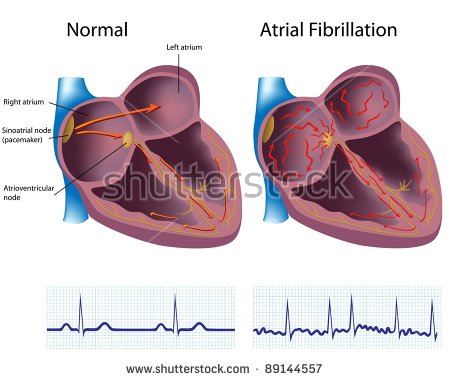
Diagnosed with Cancer? Your two greatest challenges are understanding cancer and understanding possible side effects from chemo and radiation. Knowledge is Power!
Learn about conventional, complementary, and integrative therapies.
Dealing with treatment side effects? Learn about evidence-based therapies to alleviate your symptoms.
Click the orange button to the right to learn more.
- You are here:
- Home »
- Blog »
- side effects ID and prevention »
- Paroxysmal Atrial Fibrillation- Yoga
Paroxysmal Atrial Fibrillation- Yoga

According to research linked below, yoga treats paroxysmal atrial fibrillation effectively. I have first-hand experience with atrial fibrillation. I am a long-term cancer survivor. One of the late stage side effects I developed was cardiomyopathy and atrial fibrillation.
Paroxysmal Atrial Fibrillation (PAF) scares the patient half to death when it first occurs. Many people think that they are about to die. The problems however, is that conventional therapies, listed below, don’t work well and may come with side effects.
So what is the Paroxysmal Atrial Fibrillation patient to do?
What therapies treat Paroxysmal atrial fibrillation?
Evidence-based non-conventional therapies are those therapies that research has shown to work. Yet, these therapies have not been researched and approved by the FDA. When it comes to yoga as a therapy for paroxysmal atrial fibrillation, it comes as no surprise that the FDA has not approved this therapy.
The important take-away here is that if you have PAF, yoga will help you manage just about every aspect of this challenge.
Do you have paroxysmal atrial fibrillation? If you would like to learn about additional evidence-based, non-conventional heart health therapies let me know- David.PeopleBeatingCancer@gmail.com
Hang in there,
David Emerson
- Cancer Survivor
- Cancer Coach
- Director PeopleBeatingCancer
What Is Paroxysmal Atrial Fibrillation?
“Atrial fibrillation (AFib) is a type of irregular heartbeat. If you have it, your doctor will classify yours by the reason for it and on how long it lasts. When your heartbeat returns to normal within 7 days, on its own or with treatment, it’s known as paroxysmal atrial fibrillation.
It can happen a few times a year or as often as every day. It often becomes a permanent condition that needs regular treatment…”
Effect of Yoga on Arrhythmia Burden, Anxiety, Depression, and Quality of Life in Paroxysmal Atrial Fibrillation: The YOGA My Heart Study
“The purpose of this study was to examine the impact of yoga on atrial fibrillation (AF) burden, quality of life (QoL), depression, and anxiety scores…
Results
Yoga training reduced symptomatic AF episodes, symptomatic non-AF episodes, asymptomatic AF episodes, and depression and anxiety, and improved the QoL parameters of physical functioning, general health, vitality, social functioning, and mental health domains on SF. There was significant decrease in heart rate, and systolic and diastolic blood pressure before and after yoga.
Conclusions
In patients with paroxysmal AF, yoga improves symptoms, arrhythmia burden, heart rate, blood pressure, anxiety and depression scores, and several domains of QoL. (Yoga on Arrhythmia Burden and Quality of Life in Paroxysmal Atrial Fibrillation; NCT00798356)”
Types of Atrial Fibrillation: What You Need to Know
“Atrial fibrillation (AFib) is a type of arrhythmia, or irregular heartbeat. It causes the upper and lower chambers of your heart to beat out of sync, fast, and erratically.
AFib used to be classified as either chronic or acute. But in 2014, new guidelines from the American College of Cardiology and American Heart Association changed the classification of atrial fibrillation from two types to four:
- paroxysmal AFib
- persistent AFib
- long-standing persistent AFib
- permanent AFib
You can start with one type of AFib that eventually becomes another type as the condition progresses…


